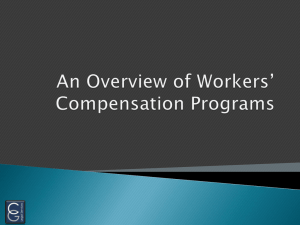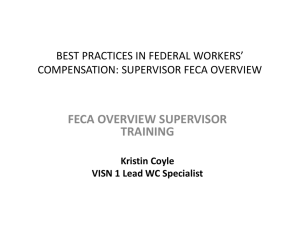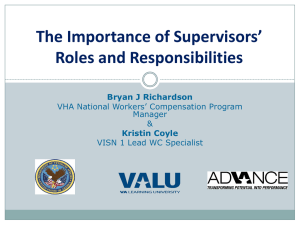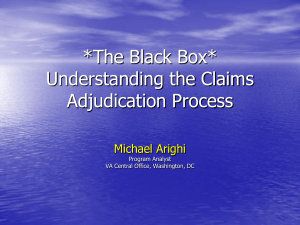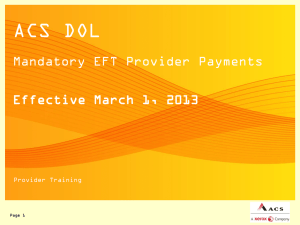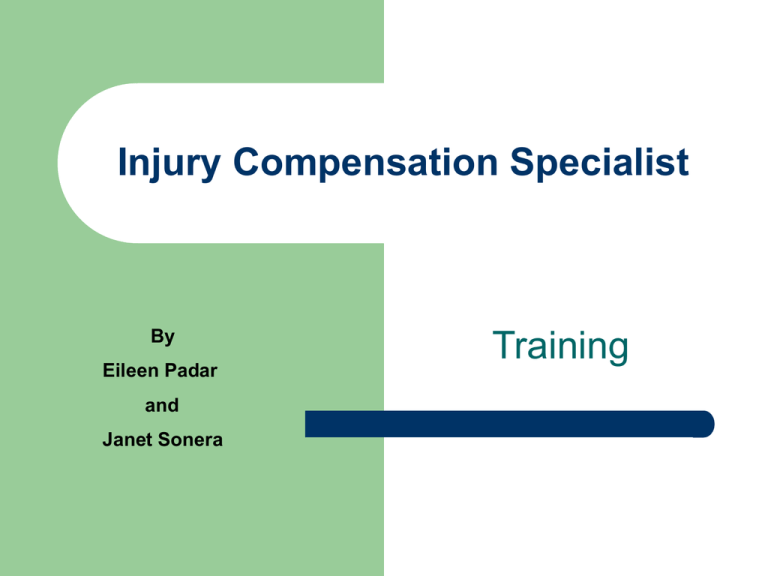
Injury Compensation Specialist
By
Eileen Padar
and
Janet Sonera
Training
FECA Overview
Federal Employees’ Compensation Act
passed in 1916.
Provides compensation to civilian employees
of the US for disability due to personal injury
or disease sustained in the performance of
duty.
Provides benefits to dependents if a workrelated injury or disease causes death.
FECA Overview
Funded through agency charge-backs.
Remedial in nature.
Non-adversarial – an attorney is not required.
Sole remedy – a federal employee or
surviving dependent is not entitled to sue the
US or recover damages for injury or death
under any other law.
FECA Overview
Administered by the Department of Labor,
Office of Workers’ Compensation Programs,
Division of Federal Employees’
Compensation.
National Office Organization.
OWCP adjudicates the claim.
12 District offices.
FECA Overview
Individual cases are protected under the Privacy Act
– only the employee, his/her representative and
agency personnel may routinely have access to
information concerning the compensation claim.
HIPAA does not apply to OWCP or employing
agencies as it relates to information concerning the
compensation claim.
No one may require an employee or other claimant
to waive his/her right to claim benefits.
Traumatic Injury
Wound or other condition of the body caused
by external force, including stress or strain.
Caused by a specific event or series of
events or incidents within a single work day
or work shift.
CA-1
Must be submitted to employing agency
within 30 days of date of injury to be eligible
for COP – however can be submitted up to
three years after the injury.
Must be transmitted to OWCP within 10 work
days from the date the agency received it.
DO NOT HOLD!
CA-1 – Agency Responsibilities
Review for completeness.
Authorize medical care.
–
Form CA-16
Advise employee of the right to elect COP.
Advise employee of his/her responsibility to
submit medical evidence.
CA-1
CA-1
Medical – CA-16
Shall be issued within 4 hours of the claimed
injury.
If verbal authorization is given, must be
issued within 48 hours.
Not required to issue more than one week
after the date of injury.
Should not be issued for Occupational
Disease claims (CA-2)
Medical - Treatment
Emergency
–
When an employee sustains a work-related
traumatic injury that requires medical
examination, medical treatment or both, the
employer shall authorize such examination and/or
treatment by issuing a Form CA-16.
Choice of Physician
–
The employee has the right to choose their own
physician.
CA-16
Occupational Disease
Condition attributable to exposure to work
factors over a period longer than one work
day or shift.
COP is not provided.
CA-16 is not issued.
CA-2
Must be submitted to employing agency
within 3 years of the date when the employee
becomes aware, or reasonably should have
been aware, of a possible relationship
between the medical condition and the
employment, or the date of last exposure.
Must be transmitted to OWCP within 10 work
days from the date the agency received it.
DO NOT HOLD!
CA-2
Checklist
–
–
–
–
–
–
–
–
CA-35a – Occupational Disease in General
CA-35b – Hearing Loss
CA-35c – Asbestos-Related Illness
CA-35d – Coronary / Vascular Condition
CA-35e – Skin Disease
CA-35f – Pulmonary Illness (Not Asbestosis)
CA-35g – Psychiatric Illness
CA-35h – Carpal Tunnel Syndrome
CA-2
CA-2
CA-2a
No medical treatment is authorized at OWCP
expense until the claim is adjudicated.
If employee was entitled to COP and 45
calendar days of COP have not been
exhausted, he/she may elect to use
remaining days, as long as 45 days have not
elapsed since the first return to work.
Employee may use sick or annual leave
pending adjudication of claim.
Conditions of Coverage
Time
Civilian Employee
Fact of Injury
Performance of Duty
Causal Relationship
Conditions of Coverage
Time
Employee has three years from:
–
–
–
Date of Injury
Date of First Awareness
Date of Last Exposure
Conditions of Coverage
Civilian Employee
FECA covers all civilian employees except
for non-appropriated fund employees.
Temporary employees covered on the same
basis as permanent employees.
Contract employees, volunteers, and loaned
employees are covered under some
circumstances.
Conditions of Coverage
Fact of Injury
Factual – Actual occurrence of an accident,
incident, or exposure in time, place, and
manner alleged.
Medical – A medical condition diagnosed in
connection with that accident, incident or
exposure.
Conditions of Coverage
Performance of Duty
Injury occurred while performing assigned
duties or engaging in an activity reasonably
associated with the employment.
Injury occurred on work premises.
–
–
–
Use of facilities for personal comfort.
Includes parking facilities owned by employer.
Coverage extended for a reasonable time before
or after work hours.
Conditions of Coverage
Performance of Duty
Injury occurred off premises while engaging
in work activities.
–
Employees are not covered en route between
work and home unless the agency furnishes
transportation, the employee is required to travel
during a curfew or emergency or the employee is
required to use their personal vehicle during the
work day.
Conditions of Coverage
Performance of Duty
Other factors
–
–
–
–
–
–
–
Recreation
Horseplay
Assault
Harassment or Teasing
Idiopathic Falls
Emergencies
Union Representation
Conditions of Coverage
Performance of Duty
Recreation: an employee is considered in
the performance of duty while engaged in
formal recreation when either the employee
is paid for participating or the recreational
activity is required and prescribed as a part
of the employee’s training or assigned duties.
Conditions of Coverage
Performance of Duty
Horseplay: an employee is considered to be
in the performance of duty if the horseplay
was of a character that could reasonably be
expected where workers are thrown into
personal association for extended periods of
time.
Conditions of Coverage
Performance of Duty
Assault: an employee is considered to be in
the performance of duty if the assault was
accidental or arose out of an activity directly
related to the work or work environment. An
assault is not compensable if it arose out of a
personal matter having no connection with
the employment.
Conditions of Coverage
Performance of Duty
Harassment / Teasing: Employees who are
harassed, teased or called derogatory names
by coworkers are considered to be in the
performance of duty provided that the
reasons for the harassment or teasing are
not imported into the employment from the
employee’s domestic or private life.
Conditions of Coverage
Performance of Duty
Idiopathic Falls: Defined as one where a
personal, non-occupational pathology causes
an employee to collapse.
Injuries that can be attributed to the
intervention or contribution of some hazard
or special condition of the employment,
including normal furnishings of an office or
other workplace are compensable.
Conditions of Coverage
Performance of Duty
Emergencies: Coverage is extended to
employees who momentarily step outside the
sphere of their employment to assist in an
emergency such as to extinguish a fire or
help a person hit by a car.
Conditions of Coverage
Performance of Duty
•
Emotional Reaction: an employee who
suffers from a medical condition resulting
from factors of employment that result in an
emotional reaction can be considered to be
in the performance of duty.
•
Personnel actions such as the regular administrative
functions of an agency (leave usage, disciplinary actions,
etc.), performance ratings, performance assessments and
informal discussions of performance, standing alone, are
not sufficient to provide coverage under the FECA. For a
personnel action to be compensable, the employee must
establish an error or abuse of administrative authority by the
agency. Without this showing, the emotional reaction is
considered to be self-generated.
Conditions of Coverage
Statutory Exclusions
Willful Misconduct – deliberate and
intentional disobedience of rules / orders.
Not carelessness.
Drug or Alcohol intoxication – proximately
caused the injury.
Intent to injure self or others – intent must be
established.
Conditions of Coverage
Causal Relationship
Link between work-related exposure/injury
and any medical condition found.
Based entirely on medical evidence provided
by physicians who have examined and
treated the employee.
Opinions of employee, supervisor, or
witnesses not considered – nor is general
medical information contained in published
articles.
Conditions of Coverage
Causal Relationship
Direct Causation – injury or factors of employment
result in condition claimed through natural and
unbroken sequence.
Aggravation – preexisting condition worsened, either
temporarily or permanently, by a work-related injury.
Acceleration – a work-related injury or disease may
hasten the development of an underlying condition.
Precipitation – a latent condition that would not have
manifested itself on this occasion but for the
employment.
Medical Benefits
Treatment
CA-16
Preventive Care
Physical Therapy
Chiropractors
Surgery
Attendant Allowance
Weighing Evidence
Termination of
Medical Benefits - Treatment
Medical services, appliances or supplies
necessary to treat the work related injury.
Any qualified physician or hospital may
provide such services, appliances and
supplies.
Medical – Physical Therapy
Physical Therapy is authorized if prescribed by the
treating physician.
PT is authorized for a period of 120 days from the
date of injury.
Additional justification needed if exceeds 120 days.
–
–
–
–
–
Specific modalities.
Diagnosis for which therapy is administered.
Specific functional deficits which are to be treated.
Expected duration and frequency of the treatment.
Specific functional goals of the additional therapy.
Medical - Chiropractors
The services that may be reimbursed are
limited to manual manipulation to correct a
spinal subluxation.
–
Cost of testing performed by or required to
diagnose such a subluxation are also payable.
A chiropractor may also provide services in
the nature of physical therapy under the
direction of a qualified physician.
Medical - Surgery
Emergency Surgery: Any procedure which needs to
be performed promptly after the onset of a condition
or injury in order to preserve life or function of an
organ or body part.
Elective Surgery: Any procedure which is necessary
for the adequate function of an organ or body part,
but which does not need to be performed promptly
after the onset of the condition in order to achieve its
purpose.
Medical - Surgery
Emergency
–
No prior authorization is required
Elective
–
Prior authorization is required.
Requires the name of the procedure; diagnosis of the
condition; the type of surgery; and the reason surgery is
needed.
Second opinion examination may be necessary.
Medical – Attendant Allowance
OWCP will pay for the services of an
attendant up to a maximum of $1,500 per
month, where the need for such services has
been medically documented.
Medical – Weighing Evidence
District Medical Adviser
Second Opinion
Independent Medical Exam
Medical – Weighing Evidence
District Medical Adviser
–
Used when the Claims Examiner needs medical
guidance to weigh the reports in file.
Evaluation of medical evidence and rendering of medical
opinion.
Interpretation and clarification of other physician’s
reports.
Has no authority to decide the facts in a case.
May create a conflict in medical opinion necessitating
referee evaluation.
May represent the weight of medical evidence for
Schedule Award claims.
Medical – Weighing Evidence
Second Opinion
–
–
–
–
–
Employee must submit to examination.
Employee may have a qualified physician, paid by him or
her, present at examination.
Employee is not entitled to have any one else present
unless authorized by OWCP.
OWCP may send a case file for a second opinion review
where actual examination is not needed.
A physician who performed a fitness for duty for an Agency
can not be considered a second opinion specialist.
Medical – Weighing Evidence
Referee Examination
–
–
A difference in medical opinion sufficient to be
considered a conflict occurs when two reports of
virtually equal weight and rationale reach
opposing conclusions.
If a conflict exists between the medical opinion of
the treating physician and the medical opinion of
either a second opinion physician or an OWCP
Medical Advisor, OWCP shall appoint a third
physician to make an examination.
Medical – Weighing Evidence –
Outcomes
Based on its determination of the weight of
the medical evidence, OWCP may:
-establish the work tolerance limitations;
-deny, terminate or reduce wage loss
compensation;
-deny or terminate medical benefits;
-resolve other claims issues that hinge on
medical evidence.
Medical – Termination of
OWCP may terminate medical benefits
when:
–
–
–
Medical documentation supports that there is no
need for further treatment.
Medical documentation supports that the effects
of the work-related condition have ceased.
Employee has been convicted of fraud against the
FECA.
Recurrence
A spontaneous return of symptoms or increase of disability due
to a previous injury or occupational disease without intervening
cause, or a return or increase of disability due to a
consequential injury.
A recurrence of a medical condition is defined as a documented
need for further medical treatment for the accepted condition or
injury when there is no accompanying work stoppage.
Wage loss resulting from the withdraw of light duty
accommodation.
No event other than the previous injury accounts for the
disability.
CA-2a
CA-2a
Continuation of Pay
Definition
Eligibility
Calculation
Controversion
Continuation of Pay - Definition
The continuation of the employee’s regular
pay for a period not to exceed 45 calendar
days of disability.
COP is not considered compensation and
therefore is subject to income taxes,
retirement and other usual payroll
deductions.
Continuation of Pay - Eligibility
Must file for a traumatic injury.
Must file the CA-1 within 30 days of the date
of injury
Must begin losing time from work within 45
days of the injury.
May resume using unused COP within 45
days after the first return to work.
Continuation of Pay - Calculation
The pay rate for COP purposes is equal to
the employee’s regular weekly pay rate.
Excludes overtime pay, but includes other
applicable extra pay except to the extent
prohibited by law.
Changes in pay which would have otherwise
occurred during the 45 day period are to be
reflected. (i.e., promotion, demotion, step
increases)
Continuation of Pay - Calculation
Full Time/Part Time – Regular Schedule
Part Time – Irregular Schedule
Intermittent, Seasonal, On-Call
COP
Controversion
The disability was not caused by a traumatic injury;
The employee is not a citizen of the United States or Canada;
No written claim was filed within 30 days from the date of injury;
The injury was not reported until after employment had been
terminated;
The injury was not sustained while in the performance of duty;
The injury was caused by the employee’s willful misconduct,
intent to injure or kill him/herself or another person, or was
proximately caused by intoxication by alcohol or illegal drugs;
or
Work did not stop until more than 45 days following the injury.
Wage Loss – COLA
An injured employee is eligible for cost-of-living
adjustments where injury related disability began
more than one year prior to the date the cost-ofliving adjustment took effect.
–
Each year, on March 1, the increase in the cost-of-living for
the preceding calendar year is determined. If the injured
employee has been entitled to compensation for at least
one year before March 1, a cost-of-living increase is applied
to the benefits.
CA-7
CA-7
CA-7a
CA-7b
Wage Loss – Termination of
Once OWCP accepts a claim, it has the
burden of justifying termination of
compensation benefits.
–
If compensation benefits are terminated, the right
to medical benefits is not necessarily affected.
Wage Loss – Termination of
Fraud Conviction
Refusal of Suitable Employment
Abandonment of Suitable Employment
Medical Evidence supports that the injured
employee is no longer disabled from work
Employee has been restored to full Earning
Capacity
Loss of Wage Earning Capacity
Section 8106 of the FECA provides for a
reduction in compensation to reflect a loss of
wage earning capacity (LWEC) when the
disability for work is partial.
–
If disability is partial, OWCP will pay 66 2/3% or
75% of the difference between the monthly pay of
the job and the monthly wage-earning capacity of
the claimant.
Loss of Wage Earning Capacity
Employee’s actual earnings may be used to
calculate reduced compensation if these earnings
are found to fairly and reasonably represent his or
her earning capacity.
As a last resort, benefits will be reduced on the basis
of an estimated earning capacity, based upon a job
not actually held by the claimant, but performed to a
reasonable extent in the commuting area and
suitable to the claimant’s vocational background.
LWEC – Shadrick Formula
On March 23, 1953, the Employees’ Compensation
Appeals Board established a principle to eliminate
economic factors such as inflation or recession when
computing the amount of monetary compensation
due for partial disability.
According to this rule, the employee would be paid
compensation based on the difference between the
pay which had been determined to be his or her
post-injury wage earning capacity, and the current
pay for the date of injury job.
LWEC – Modifying Determination
ECAB established the following criteria for
modifying a formal LWEC decision (Elmer
Strong, 17 ECAB 226):
–
–
–
The original rating was in error;
The claimant’s medical condition has changed;
The claimant has been vocationally rehabilitated.
Return to Work
CA-17
Light Duty Offers
Nurse Intervention
Vocational Rehabilitation
–
Rehabilitation Counselors
CA-17
Return to Work
Injured Workers’ Responsibilities
To seek or accept suitable employment.
To resume Federal employment if capable.
To provide physician with information on any
available light duty.
Return to Work
Employer’s Responsibilities
Authorize medical care.
If alternative positions are available for
partially disabled employees, advise the
employee in writing of specific duties and
physical demands.
Where no alternative positions are available,
advise the employee of any accommodations
the agency can make.
Return to Work
Developing a Job Offer
Section 10.506 of the CFR allows an
employing agency to monitor the injured
employee’s medical care.
Employer may contact the physician in
writing only.
Employer may contact the employee at
reasonable intervals for updated medical.
Return to Work
Developing a Job Offer
Employer must consider the physical or emotional
restrictions placed on an employee due to a work
related injury, as well as any concurrent, non-injury
related ailments.
Agency personnel can request work restrictions
directly from the physician, from an OWCP nurse, or
the OWCP Claims Examiner.
If work restrictions differ, OWCP will determine which
are appropriate.
Return to Work
Making the Offer
Description of specific job duties to be performed.
Specific physical requirements of the position and
any special demands or unusual working conditions.
Schedule.
Organizational and geographical location.
Date the job is first available.
Date by which a response to the job offer is required.
Provide pay information. Include grade, step and
salary.
Return to Work
Making the Offer
The job must be offered in writing
Must be based on medical restrictions.
Should not include information regarding the
election of OPM benefits.
Copy of the offer should be sent to OWCP
when it is made.
Copy of the injured worker’s response should
also be sent to OWCP.
Return to Work
Employee Accepts Offer
The injured worker should take the following
actions:
–
–
–
–
Notify employer of acceptance;
Contact the employer for a start date and time;
Notify OWCP of the return to work in order to
avoid overpayment; and
Prepare for a finding of wage earning capacity
after a return to work of at least 60 days.
Requesting A Job Suitability
Determination
If the injured worker accepts the offered job, there is
no need to request a job suitability determination.
Generally, if the injured worker has performed a job
for 60 days or more and is working the number of
hours he/she is capable of working, this establishes
that the job fairly and reasonably represents his/her
wage earning capacity. It is not necessary for
OWCP to make a determination concerning the
validity or suitability of the offered job in these
situations.
Return to Work
OWCP’s Action – Refusal of Offer
Determine if the job offer is valid.
–
–
–
–
–
–
Is it in writing?
Is there a description of the duties to be performed?
Is there a description of the physical requirements of the
job?
Does it state the location of the job?
Does it state the date the job is available?
Does it state the date by which the employee must
respond?
Return to Work
OWCP’s Action – Refusal of Offer
Determine if the job offer is suitable.
–
–
–
Compare the duties and the physical
requirements of the job offer to the medical
limitations on file.
Determine whether the injured worker is
vocationally capable of performing the job.
Determine whether the kind of appointment is at
least equivalent to that of the job held on the date
of injury.
Return to Work
Unsuitable Job Offers
If the employee refuses the job, the following factors
will be reviewed and the offer will be found
unsuitable if:
–
–
–
–
The offer is less than 4 hours per day when the claimant is
able to work more.
The position is for Seasonal employment, and the claimant
was not.
The position is for Temporary employment, and the claimant
was not.
Medical reports document a condition which has arisen
since the compensable injury and this condition disables the
claimant from accepting the offer.
Return to Work
Due Process
Letter to the injured worker notifying them
that the job is suitable.
Give the injured worker 30 days to provide
medical documentation supporting their
refusal.
Evaluate the evidence. If found lacking,
provide the employee with 15 days to accept
the offer.
Return to Work
Acceptable Reasons for Refusal
The position is withdrawn.
The claimant found other work which fairly and
reasonably represents his/her earning capacity.
Medical evidence establishes that the condition has
worsened and the claimant is unable to perform the
duties.
Attending physician advises employee not to accept.
Claimant is unable to travel to the job because of the
injury.
Medical condition has arisen since the compensable
injury and prevents the claimant from working.
Return to Work
Unacceptable Reasons for Refusal
Preference for the area in which he or she
currently resides.
Greater financial gain.
Spouse’s employment.
Family social ties to current residence.
Dislike of the position offered or work hours
Lack of promotion potential.
Lack of job security.
Return to Work
Unacceptable Reasons for Refusal
Retirement
Distance of the commute
Lack of medical evidence to support that
he/she can not tolerate the duties.
Personal reasons such as children.
Age
Return to Work
OWCP Finds Reasons Unacceptable
If the claimant continues to refuse the job
offer, a formal decision shall be prepared
which provides full findings of facts as to why
the claimant’s reasons for refusing the job
are deemed unacceptable and terminates
compensation.
Return to Work
OWCP Finds Reasons Acceptable
If the refusal is deemed justified, OWCP will
notify both the claimant and the employing
agency.
The claimant will be continued on the
compensation rolls with no change in
benefits.
Return to Work
Nurse Intervention
Registered Nurses (RNs) under contract to
OWCP
–
–
Meet with employees, physicians and agency
representatives to ensure that proper medical
care is being provided and to assist employees in
returning to work.
Address questions and concerns about medical
care, treatment plans, return-to-work dates,
description of work limitations and explore
availability of light or limited duty work.
Return to Work
Nurse Intervention
The RN may occasionally coordinate care with an
agency nurse. As a rule, however, agencies should
not assign their own nurses to work with employees
simultaneously with OWCP RNs.
Should an employee refuse to cooperate with an
OWCP nurse or refuse to make a good faith effort to
obtain reemployment, OWCP may reduce or
terminate compensation depending on the
circumstances of the refusal.
Return to Work
Vocational Rehabilitation
Initial Interview
Placement with Previous Employer
Medical Rehabilitation
Guidance and Counseling
Vocational Testing and Work Evaluations
Placement with New Employer
Assisted Reemployment
Follow-Up Services
Schedule Awards
The Compensation Schedule (5 U.S. Code 8107)
specifies periods of time for which compensation is
provided for the permanent loss or loss of use of
certain members, organs, and functions of the body.
–
–
Such loss or loss of use is known as permanent impairment
and may be total or partial in extent.
The law does not allow for payment of a schedule award for
impairment to the back, heart or brain.
However, a back injury may result in impairment to an
appendage, which would be eligible for a Schedule Award
Schedule Award
Form CA-7 is used to file claim for a
schedule award.
OWCP evaluates the degree of impairment
based on the specified edition of the
American Medical Association’s Guides to
the Evaluation of Permanent Impairment.
–
Current edition being used is Edition 5
CA-7
CA-7
Schedule Award
File must contain medical evidence which:
–
–
–
Shows that the impairment has reached a
permanent and fixed state and indicates the date
on which this occurred;
Describes the impairment so that the claims
examiner can visualize the degree; and
Gives a percentage evaluation of the impairment
(in terms of the affected member or function, not
the body as a whole, except for impairment to the
lungs.)
Schedule Award
Member
Weeks
Member
Weeks
Arm
312
Loss of Hearing (one)
52
Leg
288
Loss of Hearing (both)
200
Hand
244
Breast
42
Foot
205
Kidney
156
Eye
160
Larynx
160
Thumb
75
Lung
156
First Finger
46
Penis
205
Great Toe
38
Testicle
52
Second Finger
30
Tongue
160
Third Finger
25
Ovary/Fallopian Tube
52
Toe
16
Uterus/Cervix
205
Fourth Finger
15
Vulva/Vagina
205
Dual Benefits
Annuity Benefits Paid by OPM
–
–
Veteran’s Disability
–
Death Benefits
Lump Sum Payment
VA Death Benefits
Social Security Act Benefits
Tennessee Valley Authority
Black Lung Benefits
Railroad Retirement Act Benefits
Department of Justice Benefits for Survivors of Federal Law
Enforcement Officers
Benefits for Judicial Officials Assassinated in Performance of
Duty
Severance and Separation Pay
Appeal Rights
Hearing
Reconsideration
Employees’ Compensation Appeals Board
Hearing
Oral Hearing
Review of the Written Record
Hearing – Oral Hearing
Request must be made within 30 days of the formal
decision.
Held within 100 miles of the employee’s home.
Informal process.
May be held by telephone or teleconference at the
discretion of the hearing representative.
If the decision issued is unsatisfactory to the
claimant, he or she can request a reconsideration or
review by the Employees’ Compensation Appeals
Board.
Hearing – Review of the Written Record
Must be requested within 30 days of the
formal decision.
Hearing representative will review the official
record and any additional information
submitted.
If the decision issued is unsatisfactory to the
claimant, he or she can request a
reconsideration or review by the Employees’
Compensation Appeals Board.
Reconsideration
Must be submitted within one year of the formal decision.
All requests for reconsideration and supporting documentation:
–
–
–
–
Must be submitted in writing;
Set forth arguments that either shows that OWCP erroneously
applied or interpreted a specific point of law;
Advances a relevant legal argument not previously considered; or
Constitutes relevant and pertinent new evidence not previously
considered by OWCP.
If the decision issued is unsatisfactory to the claimant, he or
she can request another reconsideration or review by the
Employees’ Compensation Appeals Board. The claimant is not
entitled to request a hearing.
Employees’ Compensation Appeals
Board (ECAB)
Must be submitted directly to the Board
within 90 days of the formal decision.
Review is based solely on the record at the
time of the formal decision.
Review is limited to decisions issued within
one year.
Decisions are binding upon OWCP and must
be accepted and acted upon.
ECAB
Board does not have the authority to
authorize medical treatment or payments for
compensation.
Oral argument or written pleadings may be
submitted.
If not satisfied with ECAB decision, employee
can request that the Board reconsider its
decision within 30 days.
Third Party Claims
A party other than the US Government has
some responsibility for an injury sustained by
a federal employee during the performance
of their duty.
The responsibility for identifying a potential
third party liability in a given case lies jointly
with the OWCP claims examiner and the
Injury Compensation Specialist.
Third Party Claims
Under the FECA, when an injured employee
who is entitled to compensation for the injury,
recovers money or other property as a result
of a suit or settlement against a third party,
the injured employee has an obligation to
refund, to the United States, the
compensation that has been paid (excluding
COP).
Third Party Claims
Employee can hire an outside attorney;
Employee can settle with the third party
directly if the Solicitor of Labor concurs;
Employee can ask the agency to pursue on
his/her behalf; or
Employee can refuse to pursue (this may
result in benefits being denied).
Death Benefits
Compensation Payments
Funeral Expenses
Transportation Expenses
Payment for termination of status as a
Federal Employee
Death Benefits - Claim
Form CA-6 Official Superior’s Report of
Employee’s Death
Form CA-5 or CA-5b
CA-6
CA-5
Death Benefits - Claim
Must submit the following evidence:
–
–
–
–
–
–
–
Death Certificate
Name(s) and address(es) of next of kin
Marriage Certificate
Birth Certificate for each child
Divorce Decree or Death Certificate for prior marriages
Itemized burial bills
Medical certification establishing a causal relationship
between the employee’s death and his/her employment
Death Benefits
Beneficiary
On or After 9/7/74
Widow/Widower Only
50%
Widow(er) w/
One Child
45%
15%
Widow(er) w/
2 or More Children
45%
30%
One Child Only
40%
Two Children Only
Three Children Only
Four or More Children Only
40% + 15% (Share Alike)
40% + 15% + 15% (Share Alike)
75% (Share Alike)
Death Benefits – Terminating Status
A sum of $200 is payable to the personal
representative of the decedent to reimburse
the cost of terminating the decedent’s status
as a federal employee.
–
A spouse is considered to be the personal
representative unless incompetent.
Death Benefits – Other Beneficiaries
Child is defined as one who is under 18 years old, or incapable of selfsupport, or a full time student under age 23. (Included are
stepchildren, adopted children, illegitimate children and posthumous
children) (Excluded are married children and foster children).
Parents, grandparents, grandchildren and siblings (including
stepbrothers and stepsisters, half brothers and half sisters, and
brothers and sisters by adoption) are provided benefits if it can be
shown that they were wholly or partly dependent on the employee at
the time of death (looked to and relied upon the contributions of the
employee).
Only after the entitlements of the spouse and/or
children have been satisfied fully may other
dependents receive benefits. Total compensation on
account of death may not exceed 75%.
Death Benefits – Burial Expenses
Section 8134 of the FECA provides for the
payment of burial and funeral expenses by
the United States not to exceed $800.
ACS
Centralized Bill Payment
Accessible through Internet Portal
Accessible through AQS
ACS Web Portal Access through
Internet
ACS – Bill Status Inquiry
ACS – Bill Status Response
ACS – Bill Detail
ACS – Eligibility Inquiry
ACS – Eligibility Response
Medical Authorization Inquiry
Medical Authorization Response
THE END

